Abstract
Crude oil is probably the most complex natural chemical mixture processed in various ways to make fuel and fine chemicals among a wide range of products in industrial processing. The conditions of those industrial processes often include high temperatures, which often cause undesired chemical reactions. One of those reaction sequences is crude oil fouling, which finally results in the formation of undesired solid deposits of carbon material, a calamity that costs millions of dollars worldwide each year and produces toxic waste. However, the compounds involved in fouling, let alone the underlying reaction mechanisms, are not understood to date. Here, in order to investigate chemical fouling, the process was simulated under laboratory conditions, focusing on hydrocarbons as the main constituents of crude oil. The results demonstrate large differences within the hydrocarbon class of compounds before and after thermal treatment, even for a very light crude oil fraction, which initially does not contain any bigger or heavier compounds. Here, the fouling reaction is simulated and studied on the molecular level using high-resolution mass spectrometry. After thermal treatment, new, higher molecular weight hydrocarbon compounds with high aromaticity were detected. Results indicate that a radical reaction leads to the formation of larger and more aromatic compounds. The findings were verified by the use of a model hydrocarbon compound to study the mechanism.
1. Introduction
The term fouling describes the undesirable deposition of solid materials on a surface after thermal treatment and remains one of the biggest and, until now, unresolved problems in the petroleum industry [1]. This side reaction of petroleum processing leads to the deposition of unwanted material during upstream operation and results in the loss of thermal efficiency on the heat transfer equipment, catalyst poisoning, plugged pipelines, or thermal instability [2,3,4]. These, in turn, can cause a series of operating difficulties, which might finally end up with the units being shut down. Fouling has a great economic impact on the petroleum industry, where the removal of fouling deposits is a multi-billion dollar problem [5]. The need to control and reduce this phenomenon has become even more intense lately since incorporating heavier crude oils (e.g., extra heavy oil, oil shale) into the market is necessary to cover the world’s energy needs [6,7]. However, utilization of these types of oil is unfavorable since their high content of heteroatoms (N, O, S), metals (e.g., V, Fe, Ni), and asphaltenes cause additional problems during production, refining, storage, and transportation [8,9]. In order to overcome these problems, various attempts have been made not only to optimize the refining and related processes [10]. However, the main challenge regarding forming solid deposits is that the reaction mechanisms, let alone the compounds responsible for fouling, are poorly understood [3,11]. The ability to gain information is limited due to the complex nature of the feedstocks that can contain more than a million different chemical compounds [12], and additionally, due to the various reaction pathways (e.g., autoxidation, polymerization, and thermal decomposition) involved in fouling [13,14]. In addition, parameters such as temperature, pressure, the presence of water, or the presence of certain precursors can have a significant impact on the fouling rate [15,16,17,18,19]. Understanding the chemical composition of crude oil on a molecular level is the key to solving this problem [20,21].
Over the years, various analytical techniques have been used in fouling studies, but these are mainly focused on the characterization of the fouling deposits. Techniques such as X-ray diffraction (XRD) [22,23] or scanning electron microscopy (SEM) [24] have been successfully used to gain information regarding the morphology of the deposits (e.g., the presence of salts such as FeS and NaCl). Information about the chemical structure, the aromaticity of the sample, the chemical bonds, or the functional groups has been obtained with the use of ultraviolet-fluorescence (UV-F) [25], Fourier-transform infrared (FT-IR) [26] or nuclear magnetic resonance spectroscopy (NMR) [27], respectively [28]. However, the use of these techniques is limited since they provide only a small piece of information regarding fouling, while more frequently, several studies emphasize the characterization of the heavier fractions of crude oil since these are responsible for the physical part of fouling [29,30,31]. As part of this physical process, asphaltenes, resins, or high-molecular-weight paraffins that are stable in solution within the unaltered oil tend to accumulate and precipitate once a change in the system occurs, either by altering the operating conditions (e.g., temperature, pressure) or the composition of crude oil [1]. However, the chemical part of fouling, where compounds react with each other, forming new products that have not been present before, is still unexplored.
One of the biggest obstacles to overcome is that it is impossible to simulate an industrial-scale reaction directly in the laboratory because of all the different parameters and conditions that cannot be reproduced one-to-one. Nevertheless, in this study, attempts were made to simulate the fouling reactions under laboratory conditions, with the formation of fouling deposits being used as a guideline. Therefore, for the first time, the very complex reactions leading to fouling were simulated under laboratory conditions using a lab-built reactor and a light fraction of crude oil, which is known for its fouling tendencies. In order to understand the chemical transformation in such complex mixtures, the use of special analytical tools is required. Here, we combined the chemical reactor with ultra-high resolution mass spectrometry (UHRMS) [32,33,34,35,36] to study the reaction on a molecular level instead of only the bulk material, which was the target in most other studies. Its high mass accuracy and high resolving power enable obtaining in-depth information regarding the elemental composition of each detected signal, the level of aromaticity, and the class distribution based on the heteroatom content [37,38,39,40,41]. Although electrospray (ESI) is the most commonly used method for the analysis of polar constituents in crude oil samples, its exact mechanism and capabilities have not been fully explored [42,43,44,45]. Lately, an increasing number of reports describe a rather unexpected behavior, which involves forming radical ions from polycyclic aromatic hydrocarbons (PAHs) [46].
In this study, the fouling behavior of the hydrocarbon class within different temperature ranges and with or without the addition of water with the use of ESI is investigated. In order to understand the reaction mechanisms in detail, a model hydrocarbon compound (pyrene) was selected for additional studies on the oil fraction.
2. Materials and Methods
2.1. Simulation of Fouling under Laboratory Conditions
A lab-built reactor was used for fouling simulation. Figure 1 shows the equipment used for this purpose. The experimental set-up was as follows: A quartz crucible was filled with 0.3 mL of a light crude oil fraction and was placed inside a stainless steel autoclave. A quartz cover was set on the top of the crucible to avoid sample loss. The autoclave was then closed, using a stainless steel ring as sealing. The autoclave was positioned in a heating mold installed inside a safety box. A thermometer was connected to the heater in order to control and regulate the temperature. The sample was heated for 3 days at temperatures of 150 °C, 250 °C, 350 °C, or 450 °C. In order to test the influence of water on fouling, in a second experimental set-up, 1.0 μL of distilled water was added to the oil fraction before closing the autoclave. Experimental conditions remained the same for the experiments with and without water. The model compound of pyrene was dissolved in 0.1 mL toluene and heated for 3 days at the lowest (150 °C) and the highest (450 °C) temperature.
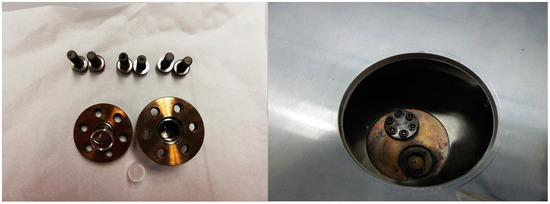
Figure 1.
Equipment used in crude oil fouling simulation: left: autoclave reactor with quartz inlet; right: heater.
2.2. Solid Deposit Analysis
The solid material was analyzed microscopically using transmission electron microscopy (TEM) and energy-dispersive X-ray spectroscopy (EDX). High-resolution imaging and chemical analysis were performed using a 200 kV electron microscope with a cold field emitter and CCD camera (Hitachi HF-2000, Hitachi, Tokyo, Japan).
2.3. Mass Spectrometric Studies and Data Analysis
For mass spectrometric analysis, a research-type Orbitrap Elite (Thermo Fisher, Bremen, Germany) was used [47]. Mass spectra were acquired using the spectral stitching method [47] (30 Da window with 5 Da overlap) in a range of m/z 200–1000 and with a resolving power of R = 480,000 (FWHM at m/z 400). All samples were first dissolved in toluene (HPLC grade, Sigma-Aldrich, Germany) and then diluted with methanol (LC-MS grade, J. T. Baker, Schwerte, Germany) (1:4 v/v) to a final concentration of 250 ppm and then analyzed without further treatment. Electrospray (ESI) in positive ion mode was used as an ionization method. The ionization was performed using a stainless steel needle at a capillary voltage of 4 kV. Nebulization was assisted by a sheath gas flow of 4.0 a.u. (arbitrary units) while the auxiliary and the sweep gas flow were set to 1.0 a.u. The transfer capillary temperature was set to 275 °C. External mass calibration was performed before sample analysis to meet a mass accuracy better than 1 ppm. The recorded mass spectra were recombined using the Xcalibur 4.0 software (Thermo Fisher, Bremen, Germany) and further processed using the Composer software (version 1.5.0, Sierra Analytics, Modesto, CA, USA). Calculations and assignments of molecular formulas were performed using the following restrictions regarding the number of possible elements and the number of double bond equivalent (DBE): H: 0–1000, C: 0–200, N: 0–3, O: 0–3, S: 0–2 and DBE: 0–100. The calculated molecular formulas were sorted into heteroatom classes based on their Kendrick mass defects and their double bond equivalent distribution. The obtained mass lists were transferred to Excel (Microsoft Office Professional 2016, Microsoft Corporation, Redmond, WA, USA) for further data evaluation. Double bond equivalent refers to the sum of the rings and double bonds present within a molecule and is calculated from the chemical composition CcHhNnOoSs of the analyte using the following equation: A higher DBE value indicates higher aromaticity of a compound.
3. Results and Discussion
3.1. Fouling in a Light Crude Oil Fraction
In order to characterize crude oil components responsible for fouling, the development of analytical methods is required. One of the biggest challenges to investigating this phenomenon was to simulate fouling conditions in the laboratory. Here, for the first time, the successful simulation of a costly and very important industrial process was achieved under laboratory conditions. Formation of solid material was observed only at the highest temperature of 450 °C after 3 days of reaction in both cases, with and without water. The resulting solid material indicates that various chemical reactions have taken place in the system, eventually forming a highly carbonaceous product, such as coke. As can be seen from Figure 2, the insoluble fouling deposit consists of more than 95 wt.% amorphous carbon.
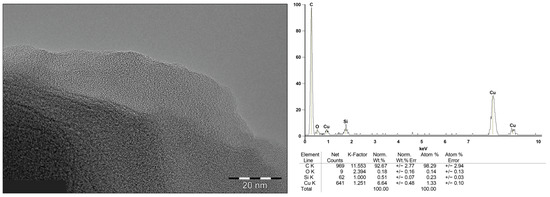
Figure 2.
Micrograph of the solid material formed from the light fraction of crude oil (left) and its elemental analysis (right) after 3 days of thermal treatment at 450 °C. The solid material was formed under conditions with and without water at 450 °C, indicating a fouling reaction.
The analysis of the fouling deposits can reveal a small piece of information regarding fouling, but unfortunately, alone, it is not adequate to study the fundamental changes within a sample on a molecular level. In order to understand the chemical changes, an investigation of the remaining components still present in the liquid phase is necessary. An inextricable part of better understanding these reactions is the investigation of the reaction mechanisms involved as well as the parameters that can influence the fouling rate. It has already been suspected that the conversion of organic compounds to insoluble products involves multiple reaction mechanisms such as autoxidation, thermal decomposition and/or polymerization [48]. In addition, according to Albright and co-workers, parameters such as temperature, nature of the sample, construction material of the reactor, and time can play a significant role in the formation of coke material [49]. Several studies have shown that an increase in the bulk temperature can increase the fouling rate, while the presence of water, which is usually added as steam for processing purposes, can cause damage in the distillation tower, corrosion of the crude oil distillation column as well as decrease the product quality [50,51]. Therefore, these conditions have been investigated in detail. Since the majority of compounds present in crude oil belong to the class of hydrocarbons, this class is investigated in detail in this study. Figure 3 illustrates the changes in purely hydrocarbon compounds based on the number of assigned compositions. The results show the differences between these species before heating (unreacted) as well as after thermal treatment at different reaction temperatures with or without water. The compounds were detected either as protonated molecules and labeled as HC[H] or radical ions and, in this case, are shown without the bracket.
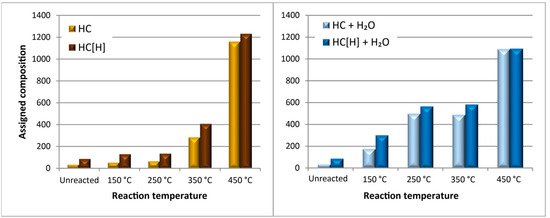
Figure 3.
Comparison of the number of compounds within the hydrocarbon class detected as radical ions (HC) or protonated molecules (HC[H]) for the gas condensate as unreacted or after thermal treatment at different reaction temperatures without (left) or with (right) water.
In the case of the unreacted oil fraction, only a few hydrocarbon compounds have been detected. This is rather expected since, according to the literature, ESI is not the method of choice for non-polar hydrocarbons. Minor changes regarding the assigned compositions can be observed at 150 °C and 250 °C without water, while a further increase in the temperature to 350 °C resulted in a slight increase in the hydrocarbon species. However, the degree of change is surprising after reaching the highest temperature of 450 °C. Here, the number of hydrocarbon species detected is ten times higher (over a thousand compounds) compared to the unreacted sample. This drastic change indicates that various chemical reactions were triggered due to the higher temperature, resulting in the formation of new compounds that ESI efficiently ionizes. Regarding the results with the addition of water, a similar trend can be observed, but in this case, the increase in the number of the assigned compositions is already apparent after thermal treatment at 250 °C.
The population-based distribution graph indicates that many differences can be observed, but a deeper look at the aromaticity of the hydrocarbon compounds will provide further information on these species. Thus, the Kendrick-type plots (DBE versus number of carbon atoms per molecule) of the hydrocarbon compounds in the form of radical ions or protonated molecules for the unreacted gas condensate and the gas condensate after thermal heating at 250 °C and 450 °C with and without water can be seen in Figure 4. Hydrocarbon radical species in the unreacted gas condensate contained 10–34 carbon atoms, with a DBE distribution in the range of 6–16. The compound with the lowest carbon number and DBE corresponds to a compound similar to dihydronaphthalene (C10H10 and a DBE of 6), while the hydrocarbon compound with the chemical formula of C20H10 and a DBE value of 16 showed the highest aromaticity. This compound corresponds to the polycyclic aromatic hydrocarbon corannulene, consisting of a central cyclopentane ring fused with five 6-membered rings, a compound that is considered to be part of heavier fractions instead of a gas condensate [52]. Hydrocarbon species detected in their protonated form exhibit slightly lower values with a carbon number of 10–21 and a DBE distribution of 4–17.
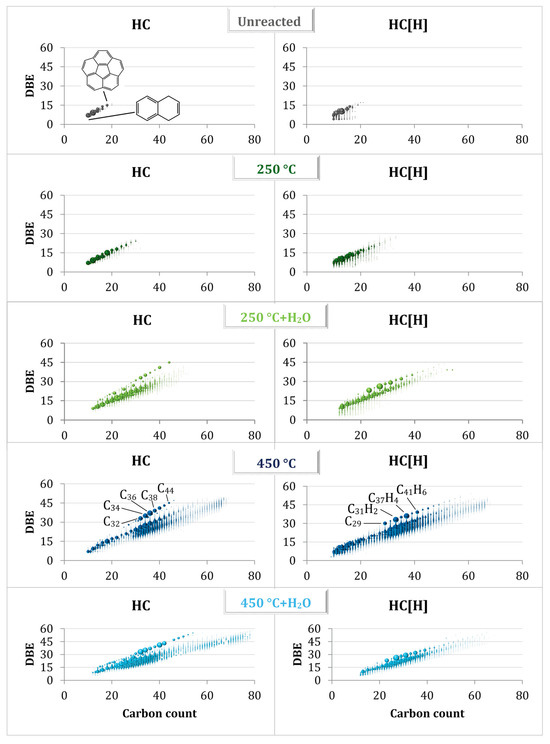
Figure 4.
DBE versus the number of carbon atoms per molecule of hydrocarbon compounds detected as radical ions (left) or protonated molecules (right) in the case of the unreacted gas condensate (top) or after thermal treatment at 450 °C without (middle) or with (bottom) water.
However, after thermal treatment at 250 °C, a different trend was observed. In this case, carbon and DBE numbers increase in the sample with and without water. Hydrocarbon species contained 12–52 carbon atoms with a DBE distribution of 6–45 in the case of radicals, while the protonated molecules exhibited values of 11–57 and 3–46, respectively. At this temperature, an interesting observation found in both cases was that a narrow band of high-intensity compositions was not present in the unreacted sample. With the further increase in temperature to 450 °C, a drastic increase in the hydrocarbon compounds with and without water can be observed in the sample. Hydrocarbon compounds reach a size of up to 72 carbon atoms with a DBE of up to 49 for the radicals and up to 73 and 53 for the protonated molecules, respectively. Similar results were observed for the heated sample with water with radical hydrocarbon compounds having a carbon number up to 79 and DBEs up to 59, while compounds with carbon numbers up to 78 and DBE values up to 55 were detected as protonated molecules.
The chemical changes occurring after thermal treatment are extremely difficult to understand since the chemistry behind fouling involves different reaction pathways. It is known that, at high temperatures, crude oil compounds undergo thermal decomposition (cracking), which can eventually lead to the formation of coke [3]. During this process, higher molecular mass hydrocarbons break down into smaller ones, usually alkanes and alkenes, with the latter ones getting further involved in the autoxidation and polymerization reactions. The Kendrick-type plots show data that indicate the formation of new, higher molecular weight hydrocarbon compounds after thermal treatment. Their formation is necessarily attributed to carbon-carbon coupling reactions, which have probably been initiated via radical mechanisms. Radical species are known to be highly reactive and can easily attack and connect to other hydrocarbon compounds, forming larger molecules. The narrow band of high-intensity compositions is indicative of the compounds being formed by dehydrogenation and fusion of aromatic systems rather than alkyl chain polymerization. In fact, long alkyl chains are not observed here. Additionally, for radical ions, a new line of compounds that are free of hydrogen can be observed on the top of the distribution. These newly formed carbon-only species can only correspond to fullerenic-type compounds [52,53]. In the case of protonated molecules, related species that contain few (2–6) hydrogen atoms within their structure are observed. After heating, small carbon molecules, fullerenes (e.g., C34, C40, C48, C60) as well as their hydrides (e.g., C16H2, C18H2, C20H2) are observed. Previous experimental studies from Kharlomov and co-workers demonstrated that such compounds were possibly formed as benzene pyrolysis products [54]. Other studies suggested that fullerene formation is a three-step process involving dehydrogenation, followed by a folding process, and finally, cage closure by C2 or C3 elimination [55,56]. Various attempts have been made to correlate the role of PAHs in fullerene formation with Taylor et al. to demonstrate that it is possible to form C60 and C70 fullerene from pyrolysis of naphthalene at around 1000 °C. The results showed that some different fullerenes can be formed by repeated addition of C10 fragments and subsequent elimination of hydrogen.
3.2. Studying the Mechanism of Fouling Using a Model Compound
For a better understanding of the reaction mechanism that leads to the formation of fouling material, a standard hydrocarbon compound (pyrene) was reacted under similar conditions. While Figure 5 illustrates the ESI mass spectrum of the unreacted compound, measurements before and after thermal treatment at 450 °C are shown in Figure 6.
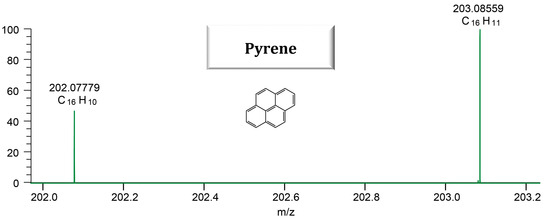
Figure 5.
Positive electrospray mass spectrum of pyrene at m/z 202.0–203.2 detected as radical ions and protonated molecules.
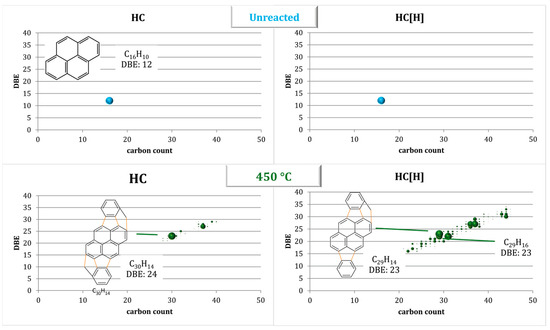
Figure 6.
DBE vs. carbon distribution Kendrick plots of the HC class detected as radical ions (left column) and as protonated molecules (right column) for the unreacted pyrene (top) and after thermal treatment at 450 °C (bottom). Possible structures of some newly created compounds are shown as insets with newly formed carbon-carbon bonds shown in orange.
As can be seen from the spectrum in Figure 5, the model compound was efficiently ionized by ESI and detected in both radical (e.g., C16H10 with DBE of 12) and protonated form (e.g., C16H11 with DBE of 11.5). As mentioned before, a better visualization of the results can be obtained using Kendrick plots. Figure 6 shows the differences in the DBE vs. carbon distribution of the HC class for the unreacted pyrene and after thermal treatment.
At the highest temperature of 450 °C, the DBE value and the carbon number per molecule are increasing, indicating that additional aromatic systems have been added to the initial model compound. It must be noted that toluene was used as a solvent, because it is present in a light crude oil fraction and can serve as a solvent and a reactant. The radical hydrocarbon compound with the highest intensity detected has a composition of C30H14 and might originate from a pyrene moiety joined with two molecules of toluene, while in the case of the protonated hydrocarbon species, the compound with the chemical formula of C29H16 is potentially derived from pyrene joined with diphenylmethane, which might be first produced from toluene. In both cases, radical ions and protonated molecules, a pattern of high-intensity signals that differ in a DBE of 4 and a carbon number of 7, i.e., one toluene moiety, can be observed. However, at this point, some structural suggestions based on the chemical compositions calculated from the experimental data are demonstrated here.
A possible reaction pathway for the generation of the compounds displayed in Figure 6 is shown in Figure 7. In this case, the reaction is likely to be initiated by forming a radical from excess toluene. Subsequently, C-C-coupling reactions can take place to join the different aromatic moieties, similar to radical polymerization reactions. Ring-closure and dehydrogenation reactions then lead to a reformation of the aromatic system. A similar process can happen multiple times, eventually leading to a compound of composition C30H14 after adding two toluene units.
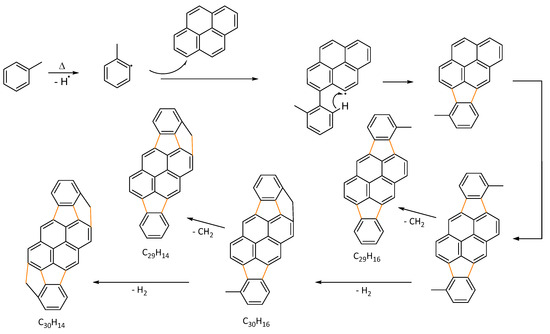
Figure 7.
Possible reaction pathway leading to the product compound C30H14 after the thermal fouling reaction of the standard hydrocarbon compound of pyrene with toluene. New bond formations are shown in orange.
4. Conclusions
The first step to solving the fouling problem in petroleum industries is to understand the reaction mechanisms involved. Although, due to the different parameters, a one-to-one transformation of an industrial process to a laboratory-sized experiment is impossible, the simulation of fouling under laboratory conditions was successfully performed in this study. The results obtained here were focused on the HC class detected with ESI as an ionization method and clearly show that high temperature plays a significant role in fouling. The formation of new hydrocarbon compounds of high molecular mass and aromaticity was observed after thermal treatment at 450 °C. These compounds were able to be ionized and detected with the use of ESI either as radical cations (HC) or as protonated molecules ([HC]). Using model compounds, some potential reaction pathways can be established. The results suggest that mainly radical-driven conjugations of aromatic moieties are taking place, potentially preceded or followed by dehydrogenation reactions. This resembles the results obtained from the real-world sample, where additions of relatively aromatic subunits were also observed, while C-C couplings involving the radical addition of alkyl chains were not observed.
The findings here show that thermal treatment of hydrocarbon mixtures initiates a radical reaction, which can lead to a large number of additional products and, to some extent, to a dehydration reaction, leading to larger aromatic structures. The consequence is that fouling could be reduced if the initial radical reaction could be suppressed. This can be a starting point in reducing fouling in petroleum processing.
Author Contributions
Methodology, formal analysis, investigation, data curation, writing—original draft preparation, A.K.; writing—review and editing, supervision, project administration, funding acquisition, W.S. All authors have read and agreed to the published version of the manuscript.
Funding
Open access funded by the Max Planck Society.
Data Availability Statement
The data presented in this study are available on request from the corresponding author.
Acknowledgments
The authors thank David Stranz (Sierra Analytics, Inc., Modesto, CA, USA) for access to new MS data handling software. The authors also thank the Electron Microscopy Department of the Max-Planck-Insitut für Kohlenforschung for their very helpful support.
Conflicts of Interest
The authors declare no conflict of interest.
References
- Deshannavar, U.; Rafeen, S.; Marappa Gounder, R.D.S. Crude Oil Fouling: A Review. J. Appl. Sci. 2010, 10, 3167–3174. [Google Scholar] [CrossRef]
- Fan, Z.; Rahimi, P.; McGee, R.; Wen, Q.; Alem, T. Investigation of Fouling Mechanisms of a Light Crude Oil Using an Alcor Hot Liquid Process Simulator. Energy Fuels 2010, 24, 6110–6118. [Google Scholar] [CrossRef]
- Macchietto, S.; Hewitt, G.F.; Coletti, F.; Crittenden, B.D.; Dugwell, D.R.; Galindo, A.; Jackson, G.; Kandiyoti, R.; Kazarian, S.G.; Luckham, P.F.; et al. Fouling in Crude Oil Preheat Trains: A Systematic Solution to an Old Problem. Heat Transf. Eng. 2011, 32, 197–215. [Google Scholar] [CrossRef]
- Müller-Steinhagen, H.; Malayeri, M.R.; Watkinson, A.P. Fouling of Heat Exchangers-New Approaches to Solve an Old Problem. Heat Transf. Eng. 2005, 26, 1–4. [Google Scholar] [CrossRef]
- Wiehe, I. Petroleum fouling: Causes, tools and mitigation methods. In Proceedings of the 9th Topical Conference on Refinery Processing, Orlando, FL, USA, 23–27 April 2006. [Google Scholar]
- Jia, C. Breakthrough and significance of unconventional oil and gas to classical petroleum geology theory. Petrol. Explor. Dev. 2017, 44, 1–10. [Google Scholar] [CrossRef]
- Miller, R.G.; Sorrell, S.R. The future of oil supply. Philos. Trans. R. Soc. A 2014, 372, 1–27. [Google Scholar] [CrossRef] [PubMed]
- Prado, G.; Rao, Y.; de Klerk, A. Nitrogen Removal from Oil: A Review. Energy Fuels 2017, 31, 14–36. [Google Scholar] [CrossRef]
- Watkinson, A.P. Deposition from Crude Oils in Heat Exchangers. Heat Transf. Eng. 2007, 28, 177–184. [Google Scholar] [CrossRef]
- Diaz-Bejarano, E.; Coletti, F.; Macchietto, S. Modeling and Prediction of Shell-Side Fouling in Shell-and-Tube Heat Exchangers. Heat Transf. Eng. 2018, 40, 845–861. [Google Scholar] [CrossRef]
- Saleh, Z.S.; Sheikholeslami, R.; Watkinson, A.P. Fouling Characteristics of a Light Australian Crude Oil. Heat Transf. Eng. 2005, 26, 15–22. [Google Scholar] [CrossRef]
- Beens, J.; Blomberg, J.; Schoenmakers, P.J. Proper Tuning of Comprehensive Two-Dimensional Gas Chromatography (GCxGC) to Optimize the separation of Complex Oil Fractions. J. High Resolut. Chromatogr. 2000, 23, 182–188. [Google Scholar] [CrossRef]
- Epstein, N. Thinking about Heat Transfer Fouling: A 5 × 5 Matrix. Heat Transf. Eng. 1983, 4, 43–56. [Google Scholar] [CrossRef]
- Watkinson, A.P.; Navaneetha-Sundaram, B.; Posarac, D. Fouling of a Sweet Crude Oil under Inert and Oxygenated Conditions. Energy Fuels 2000, 14, 64–69. [Google Scholar] [CrossRef]
- Harris, J.S.; Lane, M.R.; Smith, A.D. Investigating the Impact of Boiling Conditions on the Fouling of a Crude Oil. Heat Transf. Eng. 2017, 38, 703–711. [Google Scholar] [CrossRef]
- Ishiyama, E.M.; Paterson, W.R.; Wilson, D.I. The Effect of Fouling on Heat Transfer, Pressure Drop, and Throughput in Refinery Preheat Trains: Optimization of Cleaning Schedules. Heat Transf. Eng. 2009, 30, 805–814. [Google Scholar] [CrossRef]
- Ramasamy, M.; Deshannavar, U.B. Effect of Bulk Temperature and Heating Regime on Crude Oil Fouling: An Analysis. Adv. Mater. Res. 2014, 917, 189–198. [Google Scholar] [CrossRef]
- Ali, M.; Xing, T.Y.; Alem, T.; Chen, J.W. Investigating the role of aliphatic olefins in fouling of thermally cracked bitumen by testing fouling tendency of model aliphatic olefin compounds in light fractions. Fuel 2024, 360, 130518. [Google Scholar] [CrossRef]
- Hurt, M.; Ovalles, C.; Murray, D.; Rahimi, P. Investigation of the Chemical Composition of the Organic Material Associated with Inorganic Solids Found in Heat Exchanger Deposits: Possible Fouling Precursor in Refinery Operation. Energy Fuels 2023, 37, 14674–14687. [Google Scholar] [CrossRef]
- Lababidi, S.; Schrader, W. Online normal-phase high-performance liquid chromatography/Fourier transform ion cyclotron resonance mass spectrometry: Effects of different ionization methods on the characterization of highly complex crude oil mixtures. Rapid Commun. Mass Spectrom. 2014, 28, 1345–1352. [Google Scholar] [CrossRef] [PubMed]
- Panda, S.K.; Andersson, J.T.; Schrader, W. Characterization of supercomplex crude oil mixtures: What is really in there? Angew. Chem. 2009, 48, 1788–1791. [Google Scholar] [CrossRef]
- Pinto, D.A.M.; Camargo, S.M.C.; Parra, M.O.; Laverde, D.; Vergara, S.G.; Pinzon, C.B. Formation of fouling deposits on a carbon steel surface from Colombian heavy crude oil under preheating conditions. J. Phys. Conf. Ser. 2016, 687, 012016. [Google Scholar] [CrossRef]
- Venditti, S.; Berrueco, C.; Alvarez, P.; Morgan, T.; Millan-Agorio, M.; Herod, A.A.; Kandiyoti, R. Developing characterisation methods for foulants deposited in refinery heat exchangers. In Proceedings of the Conference: Heat Exchanger Fouling and Cleaning Eurotherm Conference, Schladming, Austria, 14–19 June 2009. [Google Scholar]
- Young, A.; Venditti, S.; Berrueco, C.; Yang, M.; Waters, A.; Davies, H.; Hill, S.; Millan, M.; Crittenden, B. Characterization of Crude Oils and Their Fouling Deposits Using a Batch Stirred Cell System. Heat Transf. Eng. 2011, 32, 216–227. [Google Scholar] [CrossRef]
- Ryder, A.G. Analysis of Crude Petroleum Oils Using Fluorescence Spectroscopy. In Reviews in Fluorescence 2005; Geddes, C.D., Lakowicz, J.R., Eds.; Springer US: Boston, MA, USA, 2005; pp. 169–198. [Google Scholar]
- Aske, N.; Kallevik, H.; Sjöblom, J. Determination of Saturate, Aromatic, Resin, and Asphaltenic (SARA) Components in Crude Oils by Means of Infrared and Near-Infrared Spectroscopy. Energy Fuels 2001, 15, 1304–1312. [Google Scholar] [CrossRef]
- Bennett, C.A.; Appleyard, S.; Gough, M.; Hohmann, R.P.; Joshi, H.M.; King, D.C.; Lam, T.Y.; Rudy, T.M.; Stomierowski, S.E. Industry-Recommended Procedures for Experimental Crude Oil Preheat Fouling Research. Heat Transf. Eng. 2006, 27, 28–35. [Google Scholar] [CrossRef]
- Zhang, Z.; Liu, G.; Chang, P.; Wang, X.; Lin, J. Fractal characteristics for coal chemical structure: Principle, methodology and implication. Chaos Solitons Fractals 2023, 173, 113699. [Google Scholar] [CrossRef]
- Wiehe, I.A.; Kennedy, R.J. The Oil Compatibility Model and Crude Oil Incompatibility. Energy Fuels 2000, 14, 56–59. [Google Scholar] [CrossRef]
- García, M.d.C. Crude Oil Wax Crystallization. The Effect of Heavy n-Paraffins and Flocculated Asphaltenes. Energy Fuels 2000, 14, 1043–1048. [Google Scholar] [CrossRef]
- Molina, V.D.; Ariza León, E.; Chaves-Guerrero, A. Understanding the Effect of Chemical Structure of Asphaltenes on Wax Crystallization of Crude Oils from Colorado Oil Field. Energy Fuels 2017, 31, 8997–9005. [Google Scholar] [CrossRef]
- Olsen, J.V.; de Godoy, L.M.; Li, G.; Macek, B.; Mortensen, P.; Pesch, R.; Makarov, A.; Lange, O.; Horning, S.; Mann, M. Parts per million mass accuracy on an Orbitrap mass spectrometer via lock mass injection into a C-trap. Mol. Cell. Proteom. 2005, 4, 2010–2021. [Google Scholar] [CrossRef]
- Panda, S.K.; Andersson, J.T.; Schrader, W. Mass-spectrometric analysis of complex volatile and nonvolatile crude oil components: A challenge. Anal. Bioanal. Chem. 2007, 389, 1329–1339. [Google Scholar] [CrossRef]
- Kondyli, A.; Schrader, W. Understanding “Fouling” in Extremely Complex Petroleum Mixtures. ACS Appl. Energy Mater. 2020, 3, 7251–7256. [Google Scholar] [CrossRef]
- Kondyli, A.; Schrader, W. Study of Crude Oil Fouling from Sulfur-Containing Compounds Using High-Resolution Mass Spectrometry. Energy Fuels 2021, 35, 13022–13029. [Google Scholar] [CrossRef]
- Panda, S.K.; Alawani, N.A.; Lajami, A.R.; Al-Qunaysi, T.A.; Muller, H. Characterization of aromatic hydrocarbons and sulfur heterocycles in Saudi Arabian heavy crude oil by gel permeation chromatography and ultrahigh resolution mass spectrometry. Fuel 2019, 235, 1420–1426. [Google Scholar] [CrossRef]
- Liu, P.; Shi, Q.; Chung, K.; Zhang, Y.; Pan, N.; Zhao, S.; Xu, C. Molecular Characterization of Sulfur Compounds in Venezuela Crude Oil and Its SARA Fractions by Electrospray Ionization Fourier Transform Ion Cyclotron Resonance Mass Spectrometry. Energy Fuels 2010, 24, 5089–5096. [Google Scholar] [CrossRef]
- Wu, Z.; Rodgers, R.P.; Marshall, A.G.; Strohm, J.J.; Song, C. Comparative Compositional Analysis of Untreated and Hydrotreated Oil by Electrospray Ionization Fourier Transform Ion Cyclotron Resonance Mass Spectrometry. Energy Fuels 2005, 19, 1072–1077. [Google Scholar] [CrossRef]
- Santos, J.M.; Vetere, A.; Wisniewski, A.; Eberlin, M.N.; Schrader, W. Modified SARA Method to Unravel the Complexity of Resin Fraction(s) in Crude Oil. Energy Fuels 2020, 34, 16006–16013. [Google Scholar] [CrossRef]
- Giraldo-Davila, D.; Chacon-Patino, M.L.; Orrego-Ruiz, J.A.; Blanco-Tirado, C.; Combariza, M.Y. Improving compositional space accessibility in (+) APPI FT-ICR mass spectrometric analysis of crude oils by extrography and column chromatography fractionation. Fuel 2016, 185, 45–58. [Google Scholar] [CrossRef]
- Jones, H.E.; Palacio Lozano, D.C.; Huener, C.; Thomas, M.J.; Aaserud, D.J.; DeMuth, J.C.; Robin, M.P.; Barrow, M.P. Influence of Biodiesel on Base Oil Oxidation as Measured by FTICR Mass Spectrometry. Energy Fuels 2021, 35, 11896–11908. [Google Scholar] [CrossRef]
- Konermann, L.; Ahadi, E.; Rodriguez, A.D.; Vahidi, S. Unraveling the Mechanism of Electrospray Ionization. Anal. Chem. 2013, 85, 2–9. [Google Scholar] [CrossRef]
- Haack, A.; Polaczek, C.; Tsolakis, M.; Thinius, M.; Kersten, H.; Benter, T. Charge Retention/Charge Depletion in ESI-MS: Theoretical Rationale. J. Am. Soc. Mass Spectrom. 2020, 31, 785–795. [Google Scholar] [CrossRef]
- Thinius, M.; Polaczek, C.; Langner, M.; Bräkling, S.; Haack, A.; Kersten, H.; Benter, T. Charge Retention/Charge Depletion in ESI-MS: Experimental Evidence. J. Am. Soc. Mass Spectrom. 2020, 31, 773–784. [Google Scholar] [CrossRef]
- Markert, C.; Thinius, M.; Lehmann, L.; Heintz, C.; Stappert, F.; Wissdorf, W.; Kersten, H.; Benter, T.; Schneider, B.B.; Covey, T.R. Observation of charged droplets from electrospray ionization (ESI) plumes in API mass spectrometers. Anal. Bioanal. Chem. 2021, 413, 5587–5600. [Google Scholar] [CrossRef]
- Schäfer, M.; Drayß, M.; Springer, A.; Zacharias, P.; Meerholz, K. Radical Cations in Electrospray Mass Spectrometry: Formation of Open-Shell Species, Examination of the Fragmentation Behaviour in ESI-MSn and Reaction Mechanism Studies by Detection of Transient Radical Cations. Eur. J. Org. Chem. 2007, 2007, 5162–5174. [Google Scholar] [CrossRef]
- Vetere, A.; Schrader, W. Mass Spectrometric Coverage of Complex Mixtures: Exploring the Carbon Space of Crude Oil. ChemistrySelect 2017, 2, 849–853. [Google Scholar] [CrossRef]
- Watkinson, A.P. Chemical reaction fouling of organic fluids. Chem. Eng. Technol. 1992, 15, 82–90. [Google Scholar] [CrossRef]
- Albright, L.F.; McConnell, C.F.; Welther, K. Types of Coke Formed During the Pyrolysis of Light Hydrocarbons. In Thermal Hydrocarbon Chemistry; Advances in Chemistry; American Chemical Society: Washington, DC, USA, 1979; Volume 183, pp. 175–191. [Google Scholar]
- Schorr Wiener, M.; Valdez Salas, B. Corrosion Problems and Solutions in Oil Refining and Petrochemical Industry. Corros. Eng. Sci. Technol. 2018, 53, 80. [Google Scholar] [CrossRef]
- Bhowmik, P.; Emam Hossain, M.D.; Ahmed Shamim, J. Corrosion and Its Control in Crude Oil Refining Process. In Proceedings of the 6th International Mechanical Engineering Conference & 14th Annual Paper Meet, Dhaka, Bangladesh, 28 September 2012. [Google Scholar]
- Farmani, Z.; Vetere, A.; Poidevin, C.; Auer, A.A.; Schrader, W. Studying natural Buckyballs and Buckybowls in fossil materials. Angew. Chem. Int. Ed. 2020, 59, 15008–15013. [Google Scholar] [CrossRef] [PubMed]
- Farmani, Z.; Vetere, A.; Pfänder, N.; Lehmann, C.W.; Schrader, W. Naturally Occurring Allotropes of Carbon. Anal. Chem. 2024, 96, 2968–2974. [Google Scholar] [CrossRef]
- Kharlamov, A.; Kharlamova, G.; Bondarenko, M.; Fomenko, V. Joint Synthesis of Small Carbon Molecules (C3-C11), Quasi-Fullerenes (C40, C48, C52) and their Hydrides. Chem. Eng. Sci. 2013, 1, 32–40. [Google Scholar] [CrossRef][Green Version]
- Goroff, N.S. Mechanism of Fullerene Formation. Acc. Chem. Res. 1996, 29, 77–83. [Google Scholar] [CrossRef]
- Berné, O.; Montillaud, J.; Joblin, C. Top-down formation of fullerenes in the interstellar medium. Astron. Astrophsics 2015, 577, A133. [Google Scholar] [CrossRef] [PubMed]
Disclaimer/Publisher’s Note: The statements, opinions and data contained in all publications are solely those of the individual author(s) and contributor(s) and not of MDPI and/or the editor(s). MDPI and/or the editor(s) disclaim responsibility for any injury to people or property resulting from any ideas, methods, instructions or products referred to in the content. |
© 2024 by the authors. Licensee MDPI, Basel, Switzerland. This article is an open access article distributed under the terms and conditions of the Creative Commons Attribution (CC BY) license (https://creativecommons.org/licenses/by/4.0/).